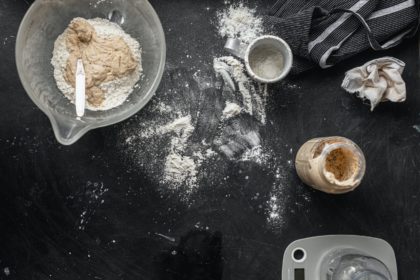
Results of the first large-scale study of sourdough starters were released last week — and the conclusions are fascinating, challenging myths about sourdough. Scientists from four different universities studied 500 sourdough starters from four continents, with an aim to determine microbial diversity.
“We didn’t just look at which microbes were growing in each starter,” says Erin McKenney, co-author of the paper and an assistant professor of applied ecology at North Carolina State University. “We looked at what those microbes are doing, and how those microbes coexist with each other.”
The most striking finding: geography doesn’t matter.
Sourdough enthusiasts preach that location and climate will alter sourdough flavor. San Francisco has long held bragging rights for the most distinctive taste profile. But, of the 500 samples, there was little evidence of geographic patterns.
“This is the first map of what the microbial diversity of sourdoughs looks like at this scale, spanning multiple continents,” says Elizabeth Landis, co-lead author of the study and a PhD student at Tufts. “And we found that where the baker lives was not an important factor in the microbiology of sourdough starters.”
Alex Corsini, CEO and founder of sourdough pizza brand Alex’s Awesome Sourdough (and TFA advisory board member), says the research “demystifies the misconception that sourdough is only good in certain pockets of the world such as San Francisco.” Great sourdough, he says, is about the raw materials.
“It further shows why sourdough is ubiquitous all over the world — starters can thrive anywhere as nature provides the magic and bakers just need to be in a position to coax out a result without ruining the magic — the magic here being the microbial balance needed to ferment and levain baked goods,” Corsini says.
The research also found there is no one single variable responsible for sourdough variations, bucking conventional baking wisdom.
“What we found instead was that lots of variables had small effects that, when added together, could make a big difference,” says Angela Oliverio, co-lead author of the study and a former PhD student at the University of Colorado, Boulder. “We’re talking about things like how old the sourdough starter is, how often it’s fed, where people store it in their homes, and so on.”
As a commercial sourdough producer, Corsini values the “low and slow” process to master a sourdough batch, especially when making it consistently on a large scale. Alex’s Awesome Sourdough undergoes a 70-hour ferment using high-quality flour, filtered water and a decades-old starter.
“Although location makes little or no impact on the starters microbial ecosystem, regulating temperature and time is fundamental and adjustments need to be made based on the location you are in (hot climate, cold climate, humidity, etc.) to get a desired result,” Corsini says. “We make slight adjustments throughout the year to ensure a consistent texture and flavor in our dough.”
The study found variations in dough rise rates and aromas were due to acetic acid bacteria, “a mostly overlooked group of sourdough microbes.” The bacteria slowed the rise time and gave the sourdough a vinegary smell. Researchers were “surprised” that 29.4% of the samples contained acetic acid bacteria.
“The sourdough research literature has focused almost exclusively on yeast and lactic acid bacteria,” says Ben Wolfe, co-author of the study, associate professor of biology at Tufts University (and also a TFA advisory board member). “Even the most recent research in the field hadn’t mentioned acetic acid bacteria at all. We thought they might be there to some extent, since bakers often talk about acetic acid, but we were not expecting anything like the numbers we found.”
The 500 sourdough starters studied mostly came from home bakers in the U.S. and Europe. Researchers performed DNA sequencing for each sample, narrowing down to 40 starters as being representative of the diversity of the original array.
Those 40 were: assessed by sensory professionals for aroma profile, chemically analyzed to determine the organic compounds released by each and then measured for dough rise time.
“I think it’s also important to stress that this study is observational — so it can allow us to identify relationships, but doesn’t necessarily prove that specific microbes are responsible for creating specific characteristics,” says Wolfe. “A lot of follow-up work needs to be done to figure out, experimentally, the role that each of these microbial species and environmental variables plays in shaping sourdough characteristics.”
“And while bakers will find this interesting, we think the work is also of interest to microbiologists,” Landis adds. “Sourdough is an excellent model system for studying the interactions between microbes that shape the overall structure of the microbiome. By studying interactions between microbes in the sourdough microbiome that lead to cooperation and competition, we can better understand the interactions that occur between microbes more generally — and in more complex ecosystems.”
The research, “The Diversity and Function of Sourdough Starter Microbiomes,” was done with support from a National Science Foundation grant.
